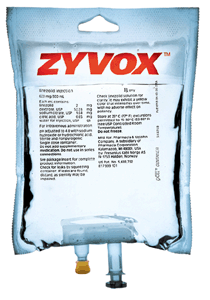
FDA ALERT [ 3/16/2007]: FDA is issuing this alert to advise you of new emerging safety concerns about Zyvox (linezolid) from a recent clinical study. This open-label, randomized trial compared linezolid to vancomycin, oxacillin, or dicloxacillin (comparator antibiotics) in the treatment of seriously ill patients with intravascular catheter-related bloodstream infections including those with catheter-site infections. In this study, patients treated with linezolid had a higher chance of death than did patients treated with any comparator antibiotic, and the chance of death was related to the type of organism causing the infection. Patients with Gram positive infections had no difference in mortality according to their antibiotic treatment. In contrast, mortality was higher in patients treated with linezolid who were infected with Gram negative organisms alone, with both Gram positive and Gram negative organisms, or who had no infection when they entered the study.
Linezolid is not approved for the treatment of catheter-related bloodstream infections, catheter-site infections, or for the treatment of infections caused by Gram negative bacteria. If infection with Gram negative bacteria is known or suspected, appropriate therapy should be started immediately. FDA is currently evaluating the new study along with other information about linezolid.
This information reflects FDA’s preliminary analysis of data concerning this drug. FDA is considering, but has not reached a final conclusion about, this information. FDA intends to update this sheet when additional information or analyses become available.
To report any serious adverse events associated with the use of these drugs, please contact the FDA MedWatch program using the contact information at the bottom of this sheet
Considerations for Physicians and Other Health Care Professionals
Linezolid is approved for the treatment of vancomycin-resistant Enterococcus faecium infections, nosocomial pneumonia, community acquired pneumonia, uncomplicated skin and skin structure infections, and complicated skin and skin structure infections, including diabetic foot infections, without concomitant osteomyelitis.
Physicians and other healthcare professionals should consider the information from this new study when deciding whether to prescribe linezolid. In this study, mortality was higher in the linezolid arm:
- in patients infected with Gram negative organisms alone,
- in those infected with both Gram positive and Gram negative organisms, and
- in patients in whom no infection was observed when they entered the study.
In patients with only Gram positive infections, however, no difference in mortality was seen between the linezolid and comparator arms.
Physicians and other healthcare professionals are reminded that
- linezolid is not approved for the treatment of catheter-related bloodstream infections or catheter-site infections.
- linezolid is not indicated for the treatment of Gram negative infections. If infection with Gram negative bacteria is known or suspected, appropriate therapy should be started immediately.
Information for the Patient
Physicians and other healthcare professionals should discuss with patients for whom linezolid might be prescribed that new but still uncertain information suggests a higher chance of death for the treatment of catheter-related bloodstream infections including those with catheter-site infections, and for those who have, or may get, infections with types of bacteria other than linezolid’s particular target.
Data Summary
Linezolid was studied in an open-label, randomized, clinical trial in patients with intravenous catheter-related bloodstream infections including those with catheter-site infections due to Gram positive bacteria. Patients in the study were randomly assigned to receive either 600 mg linezolid given intravenously or orally every 12 hours, or to one gram vancomycin given intravenously every 12 hours for 7 to 28 days. Patients in the vancomycin arm could have their therapy switched to oxacillin or dicloxacillin if the organism was methicillin-susceptible. Patients could also receive concomitant therapy for Gram negative infections. Patients with intravascular catheters were enrolled in the study if they had signs/symptoms of a catheter site infection or fever/hypothermia with other signs of infection such as hypotension, tachycardia, tachypnea, leukocytosis/leukopenia or elevated bands.
The study included 726 patients 13 years of age or older with catheter-related bloodstream infections including those with catheter-site infections. In the linezolid arm, 151 of the 363 (42%) patients had bacteremia, and in the comparator arm, 136 of the 363 (37%) patients had bacteremia. About 48% of patients were being treated in an intensive care unit and 26% were intubated.
This study showed an increased number of deaths up to 84 days after the first dose of study drug in patients treated with linezolid (78 of 363 [21·5%]) compared to those treated with comparator (58 of 363 [16·0%]). At baseline 34 patients in the linezolid arm and 32 patients in the comparator arm had Gram-negative bacteremia; an additional 28 patients in the linezolid arm and 17 patients in the comparator arm developed Gram-negative bacteremia during treatment. The greatest imbalance occurred during treatment and within 7 days following discontinuation of study drug with 43/363 (12%) deaths in the linezolid arm versus 22/363 (6%) in the comparator arm.
|
Type of organism
|
Linezolid |
Comparator |
|
|
Number died |
Number died |
|
Gram positive only
|
37/222 (16.7%)
|
37/215 (17.2%)
|
|
Gram negative only
|
4/15 (26.7%)
|
1/11 (9.1%)
|
|
Gram positive and Gram negative
|
16/46 (34.8%)
|
7/39 (17.9%)
|
|
No organism
|
20/76 (26.3%)
|
12/92 (13%)
|
|
Other
|
1/4 (25%)
|
1/6 (16.7%)
|
Current Status
Linezolid is not approved by the FDA for the treatment of catheter-related bloodstream infections or catheter-site infections. We are reviewing the information mentioned here, along with other information on the effects of linezolid to further evaluate the observed findings. We have not yet come to any final conclusions about the implications of this new study for linezolid. We intend to continue evaluating all available information and, if the review reveals additional important information to share, we will notify healthcare providers and patients.
Report serious adverse events to
FDA’s MedWatch reporting system by completing a form on line at
http://www.fda.gov/medwatch/report.htm, by faxing (1-800-FDA-0178),
by mail using the postage-paid address form provided online
(5600 Fishers Lane, Rockville, MD 20852-9787),
or by telephone (1-800-FDA-1088).





 留言列表
留言列表
 線上藥物查詢
線上藥物查詢 